British and American Financial Terms
Here are some of the main differences between British and American financial terminology.
| British | American |
| Annual General Meeting (AGM) | Annual Stockholders Meeting |
| Articles of Association | Bylaws |
| authorised share capital | authorized capital stock |
| barometer stock | bellwether stock |
| base rate | prime rate |
| bonus or capitalisation issue | stock dividend or stock split |
| bridging loan | bridge loan |
| building society | savings and loan association |
| cheque | check |
| company | corporation |
| creditors | accounts payable |
| current account | checking account |
| debtors | accounts receivable |
| gilt-edged stock (gilts) | Treasury bonds |
| labour | labor |
| Memorandum of Association | Certificate of Incorporation |
| merchant bank | investment bank |
| ordinary share | common stock |
| overheads | overhead |
| profit and loss account | income statement |
| property | real estate |
| quoted company | listed company |
| retail price index (RPI) | consumer price index (CPI) |
| share | stock |
| share premium | paid-in surplus |
| shareholder | stockholder |
| shareholders' equity | stockholders' equity |
| stock | inventory |
| trade union | labor union |
| unit trusts | mutual funds |
| visible trade | merchandise trade |
Money
| A.T.M. | abbr. Automated Teller Machine; cash dispenserUK | |
| banknote | n: a piece of paper money; billUS | |
| billUS | n. a banknote; a piece of paper money | |
| black market | n. illegal traffic in officially controlled commodities such as foreign currency | |
| bureau de change | n. establishment where currencies of different countries may be exchanged | |
| cash | n. 1 coins or bank notes (not cheques); 2 actual money paid (not credit) | |
| cash dispenserUK | n: automatic machine from which clients of a bank may withdraw money; ATM | |
| cashier | n. person dealing with cash transactions in a bank, store etc | |
| coin | n: a piece of metal money | |
| currency | n. the money in general use or circulation in any country | |
| debt | n. money etc owed by one person to another | |
| exchange rate | n. the rate at which one currency can be exchanged for another | |
| foreign exchange | n: the currency of other countries | |
| hard currency | n. currency that will probably not fall in value and is readily accepted | |
| invest | v. to put money for profit into business, land etc - investment n. | |
| legal tender | n: currency that cannot legally be refused in payment of a debt | |
| petty cashUK | n. a cash fund for small, everyday expenses | |
| soft currency | n. currency that will probably fall in value and is not readily accepted | |
| speculate | v. (risky) buying of foreign currency, land etc for rapid gain - speculation n. | |
| transaction | n. a (usually commercial) exchange; a deal - to transact v. |
Law
| attorney | n. 1 a person appointed to act for or represent another 2US lawyer | |
| barristerUK | n. a lawyer who pleads before a superior court | |
| brief | n. 1UK instructions to a barrister - alsov. 2US written statement of facts | |
| case | n. statement of the facts in a trial, esp. the argument of one side | |
| contract | n. a formal agreement, usually in writing, between two or more parties | |
| court of law | n. the place where law cases are hear and decided; court - courtroom n. | |
| evidence | n. information presented to a court to prove or support a point in question | |
| guilty | adj. responsible for wrong; culpable - guilt n. not guilty adj. | |
| judge | n. official with authority to hear and decide cases in a court of law - alsov. | |
| jury | n. a group of people chosen to hear the evidence of a case and give a decision | |
| lawsuit | n. a trial at court between two private parties | |
| lawyer | n. a person trained in law and who advises or represents others | |
| plead | v. 1 to defend a law case 2 to declare oneself to be guilty or not guilty - plea n. | |
| sentence | n. 1 decision of a court, esp. as to the punishment 2 the punishment - alsov. | |
| solicitor | n. 1UK lawyer advising clients & briefing barristers 2US law officer for a city etc | |
| sue | v. to start legal action against someone in a court of law - lawsuit n. | |
| sum up | v. to summarise & review the evidence of a case - summing up n. | |
| trial | n. a formal examination of a case in a court of law - to try v. | |
| verdict | n. the formal decision or finding of a judge or jury | |
| without prejudice | without detriment or damage to a legal right or claim |
WHAT IS MASS MEDIA
Mass media is media which is intended for a large audience. It may take the form of broadcast media, as in the case of television and radio, or print media, like newspapers and magazines. Internet media can also attain mass media status, and many mass media outlets maintain a web presence to take advantage of the ready availability of Internet in many regions of the world. Some people also refer to the mass media as the “mainstream media,” referencing the fact that it tends to stick to prominent stories which will be of interest to a general audience, sometimes ignoring controversial breaking news. Many people around the world rely on the mass media for news and entertainment, and globally, mass media is a huge industry.
Usually, mass media aims to reach a very large market, such as the entire population of a country. By contrast, local media covers a much smaller population and area, focusing on regional news of interest, while specialty media is provided for particular demographic groups. Some local media outlets which cover state or provincial news may rise to prominence thanks to their investigative journalism, and to the clout that their particular regions have in national politics. The Guardian, formerly known as the Manchester Guardian, for example, is a nationally-respected paper in England which started as a regional daily.
One of the biggest criticisms of the mass media is that it is too topical. When a media outlet is forced to cover national and international news, it cannot address numerous interesting local stories because these stories are not of interest to very many viewers. For example, the residents of a community might view their fight against development as critical, but the story would only attract the attention of the mass media if the fight became controversial or if precedents of some form were set.
People often think of mass media as the news, but mass media also includes entertainment like television shows, books, and films. It may also be educational in nature, as in the instance of public broadcasting stations which provide educational programming to a national audience. Political communications including propaganda are also frequently distributed via mass media, as are public service announcements and emergency alerts.
While elitists may be tempted to sneer at the mass media, referring to it as the “opiate of the masses,” mass media is a critical part of human societies. Understanding mass media is usually key to understanding a population and culture, which is why the field of media studies is so huge. Watching, reading, and interacting with a nation's mass media can provide clues into how people think, especially if a diverse assortment of mass media sources are perused.
WHAT IS MEDIA INDUSTRY?
An industry is a category of business. In the case of the media industry, the term refers to the collection of businesses that allows information to be shared. This includes operations such as radio broadcasts, websites, and newspapers. Jobs that are commonly available in media include positions for journalists, photographers, and producers.
Businesses within the media industry can often be sub-categorized by their mediums. There are newspapers, magazines, and television stations. There are also radio stations, website, and podcasts. Each of these are unique forms of media, although they may all be used to share the same type of information.
The media industry employs vast numbers of people in varied roles. Print media, for example, is a segment of this industry wherein people can employ their skills to be journalists, editors, and publishers. The demand for visual material provides employment opportunities for photographers and videographers. Radio affords people the opportunity to be creative directors, disc jockeys, and radio personalities.
In many places, the media industry relies heavily on protection provided in national constitutions, which often grant and protect free speech. Generally, the countries with the strongest democratic systems have the largest and most varied media industries. In many countries around the globe, censorship is a major problem. When this is the case, participants in this industry are often at risk of persecution if they attempt to disseminate information that their governments do not find favorable. Some countries even go so far as to limit the access that people in their nation have to international media.
The media industry is considered to be a powerful tool if properly used. It can be used to influence masses of people. For this reason, the media industry is one toward which people commonly have mixed feelings. On the one hand, it is generally understood that the media industry serves some very useful and essential functions. Some of the businesses in this category inform people of important information, such as when the radio is used to announce threatening weather or the newspaper is used to display public notices.
On the contrary, the media industry is also commonly criticized for destroying values or providing a platform for extremism. Examples of this may include instances when obscene behavior is flaunted on talk shows or racists are allowed to distribute newsletters. In some cases, the media is even accused of threatening public safety, such as when the details of classified government documents are exposed on the Internet.
ALTERNATIVE MEDIA
Alternative media is generally considered to be any type of media that is not under the control of a business operation or syndicate, or a government agency. This form of media may involve traditional outlets such as newspapers and magazines, or radio, television, and movies. Alternative media may also involve the newer media outlets of web sites, e-books and e-magazines, streamed audio and video, or other media outlets that are found online.
The main function of alternative media is to offer a different perspective that what is presented in the media that is under the control of a government or a big business. At one time, alternative media was also known as counter-cultural or underground media, terms which helped to identify the media outlets that provided opportunities for dissenting points of view and ideas to be shared outside the established media. This was often thought necessary when other media alternatives were unwilling or unable to offer these dissenting views equal time with views that were more widely held.
While alternative media has been around for centuries, the concept did not begin to emerge as a specific form of media communications until the middle of the 20th century. As social unrest became more prominent in a number of nations, people with alternative points of view on issues such as race, religion, lifestyle, orientation, politics, and social organization began to use small presses to create their own publications. Brochures, newspapers, and eventually magazines provided a foundation for what was soon identified as fringe media, denoting the fact that these views were not generally held by the majority of the populace. By the 1960’s, alternative media has branched out from printed publications to the inclusion of low budget movies, as well as independent radio and television broadcasts that were syndicated on low-frequency media outlets.
Many alternative media publications begin life on shoestring budgets that make it necessary to utilize the most cost-effective means of printing and distributing the materials. Over time, a number of these underground or alternative publications build considerable reader bases, and are able to increase the scope and the quality of their work. Others remain publications that serve a niche base of readers and continue to operate with relatively little resources.
One of the innovations in recent years has been the use of the Internet as a form of alternative media. While underground radio, television, and movies have been around for decades, the creation of alternative web sites that focus on minority points of view in politics, music, fashion, lifestyle, and other areas have proliferated. Today, it is possible to find media online that addresses just about any idea, concept, or opinion by conducting keyword searches using a reliable Internet browser. These online media outlets continue to offer the opportunity to explore different understandings and ideas that are either overlooked media, or receive relatively little attention from the more conventional media outlets.
MEDIA IMPERIALISM
Media imperialism is a theory that suggests smaller countries are losing their identity due to the dominance of media from larger nations. It can be equated to small community shops closing down due to large superstores moving in, taking over and having a monopoly. As the larger media corporations begin to take over, smaller media companies are either being forced out or swallowed up. When the majority of media available in one country is that produced by a different, more dominant nation, it is suggested that the culture of that larger nation, along with its interests, displace that of the home country.
Many critics argue that there is too much media coverage of the events in a limited number of large nations as opposed to the rest of the world. This coverage may be affected by the dominance of media companies in these larger countries, which have the ability to control the content and amount of media coverage on a particular issue. Critics suggest that this media imperialism has led to important events getting little attention, and biased information and inaccuracy within news stories.
Media imperialism is not just seen internationally. When a small number of companies are responsible for large amounts of media output, this too may be considered media imperialism. Countries including Canada and Italy are often accused of having imperialist media. A large amount of the media in these two countries is controlled by just one company in each.
The problem with just one company or owner controlling the media is that media output can be biased. The owner can decide on what information is shown, as well as what to censor. This can sometimes come down to an influence from the country's government, which may have the power to shut down the company if it does not follow the government's wishes. Other times, powerful corporate interests can influence the media, either through their influence with the government or their role as advertisers.
Advertisers use media companies to promote their goods, but in some cases can also lay down stipulations on the content produced. If a media organization earns a significant part of its revenue through advertising channels, these advertisers can have an undue influence on what is shown. In such cases, the content of the broadcasting is down to its profits; if programming does not bring in profits, it is unlikely to survive for long.
In the United Kingdom, the British Broadcasting Corporation (BBC) operates its own form of media imperialism. The BBC has an annual television license that all television owners must purchase, regardless of whether those owners watch the BBC or not. The BBC was created by Royal Charter, but operates independently from the government.
The BBC's television license fee has caused much controversy over the years, and failure to pay for a license can result in a fine. There are a number of channels available to watch on British television, but only the BBC has the right to charge for theirs. It is not strictly thought of as media imperialism, as the content of the BBC is mainly British, though some may argue that it may not represent the multiculturalism present in Britain.
Especially as new technology allows more people from around the world to make their voices heard, there are an increasing number of critics who argue that media imperialism is not the threat it once might have been. Access to social media tools has allowed groups who might have been censored in the past to make their stories more widely known. Even older technologies, such as radio, can be very effective tools to allow a greater diversity of voices in the media landscape. Some critics even argue that, rather than passively accepting the cultural values that foreign media might impose on a smaller nation, people in those nations often pick and choose the aspects of that media that reinforces local values.
| Newspapers: A Brief History | ||||||||
For centuries, civilizations have used print media to spread news and information to the masses. The Roman Acta Diurna, appearing around 59 B.C, is the earliest recorded “newspaper”. Julius Caesar, wanting to inform the public about important social and political happenings, ordered upcoming events posted in major cities. Written on large white boards and displayed in popular places like the Baths, the Acta kept citizens informed about government scandals, military campaigns, trials and executions. In 8th century China, the first newspapers appeared as hand-written newsheets in Beijing.
The printing press, invented by Johann Gutenberg in 1447, ushered in the era of the modern newspaper. Gutenberg’s machine enabled the free exchange of ideas and the spread of knowledge -- themes that would define Renaissance Europe. During this era, newsletters supplied a growing merchant class with news relevant to trade and commerce. Manuscript newssheets were being circulated in German cities by the late 15th century. These pamphlets were often highly sensationalized; one reported on the abuse that Germans in Transylvania were suffering at the hands of Vlad TsepesDrakul, also known as Count Dracula. In 1556 the Venetian government published Notizie scritte, for which readers paid a small coin, or “gazetta”. In the first half of the 17th century, newspapers began to appear as regular and frequent publications. The first modern newspapers were products of western European countries like Germany (publishing Relation in 1605), France (Gazette in 1631), Belgium (Nieuwe Tijdingen in 1616) and England (the London Gazette, founded in 1665, is still published as a court journal). These periodicals consisted mainly of news items from Europe, and occasionally included information from America or Asia. They rarely covered domestic issues; instead English papers reported on French military blunders while French papers covered the latest British royal scandal.
The invention of the telegraph in 1844 transformed print media. Now information could be transferred within a matter of minutes, allowing for more timely, relevant reporting. Newspapers were appearing in societies around the world. Japan’s first daily newspaper, Yokohama Mainichi Shimbun, appeared in 1870 (although printing from movable type was introduced in Japan in the late 16th century).
By the middle of the 19th century, newspapers were becoming the primary means of disseminating and receiving information. Between 1890 to 1920, the period known as the “golden age” of print media, media barons such as William Randolph Hearst, Joseph Pulitzer, and Lord Northcliffe built huge publishing empires. These men had enormous influence within the media industry, and gained notoriety for the ways in which they wielded their power. Newspapers have also played a role as disseminators of revolutionary propaganda. Iskra (The Spark), published by Lenin in 1900, is one notable example. On June 21, 1925, Thanh Nien made its debut in Vietnam, introducing Marxism to the country and providing information on the revolution’s strategic policies. Broadcast radio exploded onto the media scene in the 1920’s. Newspapers were forced to re-evaluate their role as society’s primary information provider. Like the new media technologies of today, the development of a low cost, alternative media source produced rumblings that radio would topple the newspaper industry. To respond to this new competition, editors revamped the paper’s format and content in order to broaden their appeal, and stories were expanded to provide more in depth coverage.
The technological revolution of today is creating new challenges and opportunities for traditional media. Never before has so much information been so accessible to so many. By the end of the 1990s, some 700 had web sites; today there are thousands. The amount and immediacy of information on the Internet is unparalleled, but it has not signaled the end of the newspaper’s relevance. Newspapers in print remain a popular and powerful medium for the reporting and analysis of events that shape our lives. |
The news has at one point or another played a part in every one of our lives. Whether it is a weather report giving flash-flood warnings, information on presidential campaigns, or an obituary citing the death of a television personality, we crave it. Until the recent development and affluence of the Internet as a news source, newspapers have globally been the primary source of current events. Having become part of a daily routine in most lives, little is known of the immense history this learning tool holds.
The story begins some five centuries ago in Europe. Here, merchants would distribute newsletters written by hand containing information regarding the weather, economic conditions, wars and human-interest stories. Although this was the first known form of distributed written information, the country accredited with the creation of the first newspaper is Germany. In the late fifteenth century, a cross between a brochure and a pamphlet was dispersed among the people, the text containing highly sensationalized stories along with description of the current news events.
America, however, was a step behind. Publick Occurrences, Both Foreign and Domestick, was the first newspaper published in America. Printed by Richard Pierce, and edited by Benjamin Harris, the first copy issued on September 25, 1690 would also be the last. It filled only 3 sheets of paper measuring six by ten inches, the equivalent of filling half of the front page of a newspaper today (14" x 23"). The paper had intended to be issued once a month.
The sudden discontinuation of Publick Occurrences would mean the last news offered to Americans for the next few years. Instead, newspapers published in London were read even though the "first true newspaper in English was the London Gazette, published four years later in 1666.
Fourteen years later, back in America, John Campbell, a bookseller appointed Postmaster of Boston, became the editor of the Boston News-Letter. The first issue was dated Monday, April 17 to Monday April 24, 1704 and contained only one advertisement. This was produced weekly and continued to be so even when William Brooker was appointed Postmaster to replace Campbell. Campbell refused to authorize the use of the title "News-Letter" to anyone else so Brooker called his newspaper the "Boston Gazette". Seven months later, Philip Musgrave was awarded the position of Postmaster in Boston and replaced Brooker. At this time, James Franklin, the printer of the Gazette, was also replaced. He wanted to start his own newspaper even though friends and family dissuaded him from doing so by telling him that Boston already had a sufficient number of newspapers (2) and a third could not survive. Despite this, Franklin went ahead and published his own newspaper, the New England Courant. The first issue was printed on August 19, 1721 making it the fourth newspaper published in America.
When James Franklin published an editorial criticizing the government, he was sent to prison. James' 13 year old brother and apprentice, Ben, took over the work of laying type, printing, and delivery of the issues. Six months later, James Franklin was forbidden to publish any more newspapers so the masthead now carried the name "Ben Franklin" as editor and publisher. Ben, now legally free of being an apprentice, and having a dislike for his brother James, ran away to New York and later to Philadelphia. The New England Courant kept publishing issues claiming Ben Franklin was editor and publisher until 1726 without anyone being the wiser.
The fact that newspapers had been so scarce in Europe, America, and many other continents is due to many factors. To find a literate man was no easy task after Europe was emerging from the black age. Paper was extremely expensive, and hard to come across, and the task of printing was long and laborious. The latter was still a problem even with the invention of the printing press in 1436.
A 39-year-old Johann Gutenberg came up with a printing method, where, by arranging stamps displaying the letters of the alphabet, one could construct a page of literature to be copied numerous times. This became known as the Gutenberg Press, one of the greater inventions the fifteenth century held. Although a giant improvement from hand copying, this method still required the rearrangement of the letters each time a new page was to be printed.
In the early 1800's the development of continuous rolls of paper enhanced the original Gutenberg Press as did a steam-powered press and a way to use iron instead of wood for building presses. This added efficiency of printing made the prices of printed goods more reasonable hence the term "penny press". This phrase originated when newspaperman Benjamin Day dropped the price of his New York Sun to a penny a copy in 1833. Historians have accredited the "penny press" as the first true mass medium.
Another advancement in the history of printing was the origin of Linotype, a method of creating movable type by machine instead of by hand. This was introduced in 1884 and marked a significant leap in production speed. In terms of the use of computers in the field of printing, especially newspapers, the progression is unbelievable. From the first daisy-wheel and dot matrix "impact" printers to common use of the non-impact printers: ink-jet, laser and thermal-transfer, printing presses are on the brink of becoming a thing of the past.
The big question regarding what the future holds for the old-fashioned newspaper is whether or not it will be overcome by the use of the Internet. Studies show that from 1992 to 1997, the weekly hours of using the Internet has increased from 1.8 hours, to 9.1. Although the evidence is convincing that in the future the use of computers will obliterate that of newspapers, sometimes the tangible aspect is too great to give up for a color monitor. You may be convinced that there's no better way to relax than with some black coffee and the front page. Or perhaps up-to-the-minute updates on top stories are more your interest. All we can say is: To each his own, but always keep an open mind.
The History of Advertising
Introduction
“Advertising, a form of commercial mass communication designed to promote the sale of a product or service, or a message on behalf of an institution, organization, or candidate for political office.”
Advertising can be looked at from various perspectives. As the quote above states, its purpose is to increase the number of articles or products sold. These are not only things we can buy in different stores, for example clothing or supplies for our daily life, but also such simple things as a message placed by an institution or organization asking for attention of the public to raise money or to make them aware of a problem, such as anti-smoking ads. Even political parties use advertisements and commercials to state the opinion of their candidate. I think we have all experienced that quite extensively during the presidential campaign in the United States.
Advertising became big business in the 20th century, offering many different jobs in advertising agencies and the marketing section. The use of the media, like newspapers, television, direct mail, radio, magazines, outdoor signs and of course the Internet made this growth possible. It is a form of transporting information to the consumer, but which does not only have positive sides. There are many critical aspect about it, like persuading people to doing unhealthy things, like smoking, or producing special stereotypes everybody tries to follow. Nevertheless, advertising has become international, since producers and companies try to sell their products on a globalized market in almost every corner of the world. It is therefore not surprising to see a big sign for Coca Cola in third world countries.
We would like to look at different aspects of advertising a little closer in our team work, including its history and development as well as new approaches, the methods used and the impact it can have in certain areas.
In the 19th century new technologies were developed and brand-new methods invented. As a result a surplus of production was formed. Warehouses of many factories were overflowing. In this way it was necessary to create useful advertisements, which would cover all large spaces, utilizing a large variety of mass media sources. The first advertising agent who created such a network was Volney Palmer. In 1841 he proclaimed himself as an advertising agent in Philadelphia and then created similar offices in Boston and New York. About 20% of the commission for media brokers was paid to the publishers. Texts of ads were offered by the head of the company or its representative. People who wanted to put their ads in the newspaper paid him a commission. Such activities became very popular during the second part of 19th century in all European countries.
Significant advances in advertising development were made by American brokers. In the early 1850’s, John Wanamaker caused a revolution in the retail trade. He created a price lists for a variety of goods and returned the money if the commodity was not of the promised quality. As a result, he gained a lot of profit by using this strategy and he then opened a network of consumer goods shops. The reason of such great success was professional advertising.
Harper's Weekly, September 26, 1868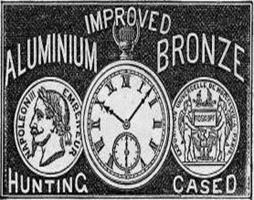
In 1880 businessmen employed the best creator of advertising texts – D. E. Powers. Powers started to develop advertisements using brand-new information. This strategy had become very popular in American trade circles and by the 20th century advertising had become a form of science.
“In the 1880s a new era of advertising began: New methods of manufacturing led to greatly increased output and decreased the costs for the producers of consumer goods. The products now could be packaged at the plant. Moreover the telegraph network was in place and the continent has been crisscrossed by a network of railroads….” All these were assumptions that now allowed nation-wide distribution and nation-wide advertising. This state supported the growth of advertising agencies and dictated their activities.
The most widely advertised consumer products at this time had been patent medicines.
In 1893 more than half of over a hundred firms spending more than fifty thousand dollars annually on advertising were patent medicine manufacturers. But only 20 years later, most of these firms were no patent medicine manufacturers anymore but manufacturers of food, soap, cosmetics and automobiles. These firms began to market their packaged goods under brand names. Some of the first brands were firms like Ivory, Colgate, Wrigley and Coca Cola.
Colgate & Co. Toilet Soaps
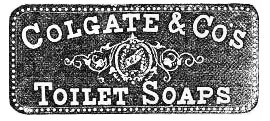
Previously such everyday household products like milk, sugar, soap, rice and candles had been sold in neighborhood shops from bulk packages.
Victor: The Only Perfect Lawn-Mower in the WorldHarper's Weekly, April 20, 1872 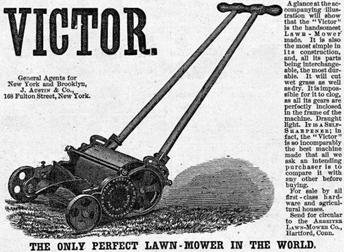
During 19th century the majority of advertisements were published in the newspapers and advertising leaflets. Although newspapers were a prerogative of well-off class of community but the situation began to change in the early 1860’s when people got the opportunity of receiving publications by post. First magazine advertisements appeared in The Southern Messenger. For a few years the editor of this magazine was Edgar Po. Many of the magazines that began to publish advertisements as the separate charter in the 19th century have continued doing it nowadays. Such editions are Cosmopolitan, Ladies’ Home Journal, Readers Digest and some others.
Despite of the popular brands of newspapers the majority of information in the advertisements was unreliable and apocryphal. Moreover advertisements sometimes were immoral and absurd. For example in the countryside of one American city advertisement was placed in the monument of a non-existent person and it stated: “This person killed himself with the handgun with Colt system”. Then “publishers” enumerated the value of this handgun. As the result of such inhuman actions people stopped trusting advertisements and began to consider advertising as something negative.
John B. Dunham PianosTestimonials from several musicians
Harper's Weekly, December 31, 1864
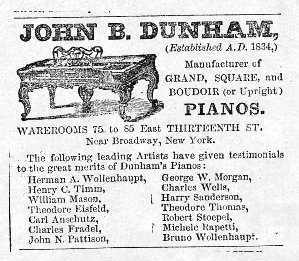
The situation radically changed in the 20th century, the heyday of legal regulations in advertising, a process that the U.S.A. was very influential in.
Advertising agencies today are highly specialized companies which employ a large number of people in a variety of business and creative skills, including advertising and marketing specialists, designers, copy writers, artists, economists, psychologists, researchers, media analysts, product testers, librarians, accountants, bookkeepers, and mathematicians. This business sector makes billions of dollars each year, depending on the economical growth and development of a country but also enhancing exactly this.
The agencies make money in different ways, buying time for an ad on radio or television for a customer or space for an ad in a newspaper of magazine. They always keep up to 15% of the cost as a commission, which has become a standard in the advertising industry and covers a huge part of the agency’s income. Of course, the range of offers of an agency is much bigger than simply providing space or time for ads on TV, radio, newspapers or magazines. They offer their customers whole packages of approaches for a specific population group.
The first radio-advertisement was broadcast in 1922 in New York on the WEAF radio station.
Thus in the 1920s advertisers and their agents had come to realize radio's possibilities. With its drama and immediacy, radio could convey their message directly to the consumer who would not need to purchase a publication or even need to be literate.
In the 1950s television was introduced and quickly developed into THE advertising-media. In the 1950’s common income from the advertising industry rose to $ 10 billion a year. In 1980’s this index was $ 100 billion! Now advertisers could demonstrate the use of their products and present well-known figures to praise it. They could also affect emotions through television.
Today advertisers spend millions of dollars for their campaigns, although they don't always know how effective their advertising dollars really are.
The Coca-Cola Company
Introduction
In 1886 Civil War veteran and Atlanta pharmacist John Pemberton rather coincidentally created one of the world’s most famous drinks. The mix of fragrant, caramel-coloured liquid and carbonated water was called “Coca-Cola” by Pemberton’s bookkeeper.
After selling only 9 glasses of Coca-Cola a day in the company’s first year, Pemberton, who had no idea of his having created one of the world’s most successful products, sold the company to Atlanta businessman Asa Griggs Candler in 1891. As Coca-Cola’s first president, he was the first one to bring real vision to the business and the brand.

 Julius Caesar
Julius Caesar  Johann Gutenberg
Johann Gutenberg 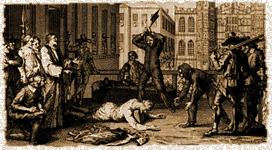 Beheading of Charles I
Beheading of Charles I 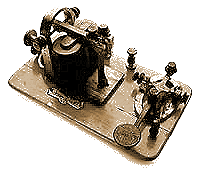 Newspaper content began to shift toward more local issues in the latter half of the 17th century. Still, censorship was widespread and newspapers were rarely permitted to discuss events that might incite citizens to opposition. Newspaper headlines did announce the beheading of Charles I at the end of the English Civil War, although Oliver Cromwell tried to suppress all newsbooks on the eve of the execution. In 1766, Sweden was the first country to pass a law protecting press freedom.
Newspaper content began to shift toward more local issues in the latter half of the 17th century. Still, censorship was widespread and newspapers were rarely permitted to discuss events that might incite citizens to opposition. Newspaper headlines did announce the beheading of Charles I at the end of the English Civil War, although Oliver Cromwell tried to suppress all newsbooks on the eve of the execution. In 1766, Sweden was the first country to pass a law protecting press freedom.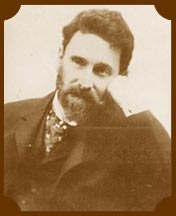 Joseph Pulitzer
Joseph Pulitzer  No sooner had newspapers adapted to radio than they were forced to re-evaluate themselves in light of a new and more powerful medium: television. Between 1940 and 1990, newspaper circulation in America dropped from one newspaper for every two adults to one for every three adults. Despite this sharp decline, television’s omnipresence did not render the newspaper obsolete. Some newspapers, like USA Today, responded to the technological advancements by using color and by utilizing the “short, quick and to the point” stories that are usually featured on television.
No sooner had newspapers adapted to radio than they were forced to re-evaluate themselves in light of a new and more powerful medium: television. Between 1940 and 1990, newspaper circulation in America dropped from one newspaper for every two adults to one for every three adults. Despite this sharp decline, television’s omnipresence did not render the newspaper obsolete. Some newspapers, like USA Today, responded to the technological advancements by using color and by utilizing the “short, quick and to the point” stories that are usually featured on television.